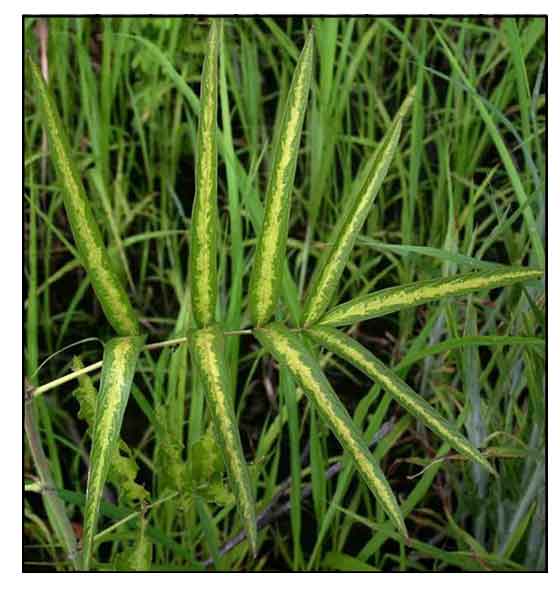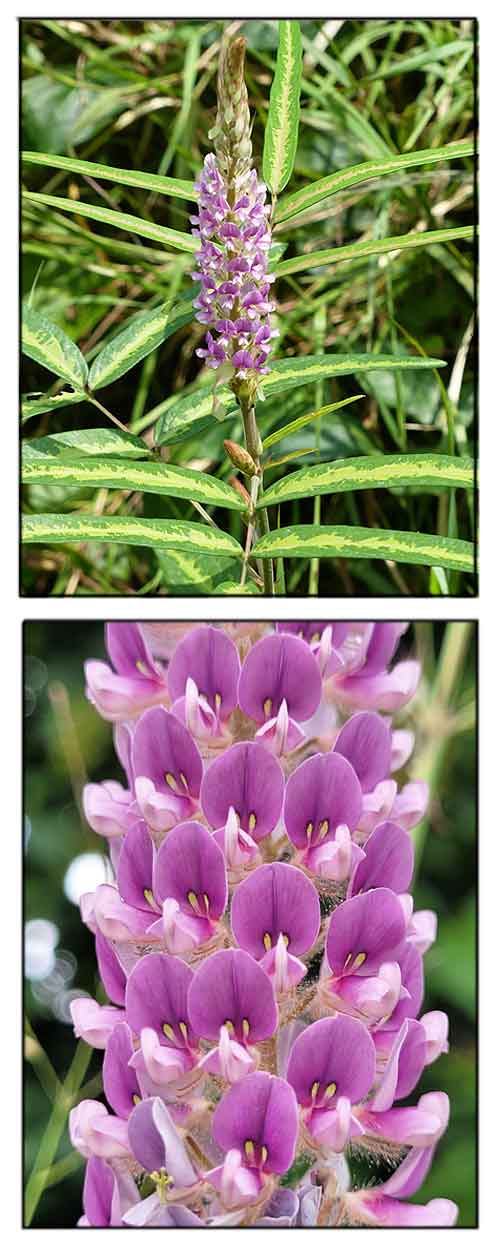 Gen info Gen info
- Uraria is a genus of plants in the legume family, Fabaceae. It includes 24 species of shrubs and subshrubs native to sub-Saharan Africa, the Indian Subcontinent, Indochina, China, Malesia, Papuasia, Austraila, and the South Pacific.
-
The species Uraria picta was described in 1825.
Botany
• An annual woody herb, up to 1 meter. Leaves: Lower leaves are 1-3-foliolate, upper 5-9-foliolate. Leaflets of the lower leaf 2-8 cm long, 2-3 cm broad, ovate; of upper leaves, 7-25 cm long, 5-25 mm broad, ovate-lanceolate, pointed, often variegated, stalk 3.5-6.5 cm long. Inflorescence is 10-70 cm long, carried on a 0-5 cm long stalk. Bracts are 1.4-2.5 cm long, long pointed, completely covering the bud, deciduous. Flowers: Flowers stalks are 6-9 mm long. Sepals are 4-5 mm long. Flowers are purple, pink or bluish, 8-9 mm long. Fruit: Fruit 5-9 mm long, with 3-6 segments, each 2-3 mm broad, glabrous, smooth, polished, folded on one another. (5)
• Painted Uraria is an erect perennial, undershrub, 1-6 ft tall, branches velvety. Lower leaves are 1-3-foliolate, upper 5-9-foliolate. Leaflets of the lower leaf 2-8 cm long, 2-3 cm broad, ovate; of upper leaves, 7-25 cm long, 5-25 mm broad, ovate-lanceolate, pointed, often variegated, stalk 3.5-6.5 cm long. Inflorescence is 10-70 cm long, carried on a 0-5 cm long stalk. Bracts are 1.4-2.5 cm long, long pointed, completely covering the bud, deciduous. Flowers stalks are 6-9 mm long. Sepals are 4-5 mm long. Flowers are purple, pink or bluish, 8-9 mm long. Fruit is 5-9 mm long, with 3-6 segments, each 2-3 mm broad, smooth, polished, folded on one another. (FlowersOfIndia)
 Distribution Distribution
- Native to the Philippines.
- From north Luzon to Mindanao; occasional in open grasslands and thickets at low and medium elevation. (2)
- Also native to Angola, Assam, Bangladesh, Benin, Bismarck Archipelago, Burkina, Cambodia, Cameroon, Central African Republic, Chad, China South-Central, China Southeast, Congo, East Himalaya, Ethiopia, Gabon, Gambia, Ghana, Guinea, Guinea-Bissau, Gulf of Guinea Is., India, Ivory Coast, Jawa, Liberia, Malawi, Malaya, Mali, Mozambique, Myanmar, Nansei-shoto, Nepal, New Guinea, Nicobar Is., Niger, Nigeria, Pakistan, Queensland, Rwanda, Senegal, Sierra Leone, Sri Lanka, Sudan, Taiwan, Tanzania, Thailand, Togo, Uganda, Vietnam, West Himalaya, Zaïre. (1)
Constituents
- Phytochemical studies have isolated phenolics, fatty acids, flavonoids, steroids, triterpenoids and alkaloids.
- Rhoifolin, an apigenin glycoside (Apigenin-7-O-neohesperidoside) has been isolated and considered a marker compound of U. picta. (6)
- Qualitative phytochemical analysis of methanol extract of leaves (L). stems (S) and roots (R) yielded alkaloids (all), flavonoids (all), steroids (LR), terpenoids (all), cardiac glycosides (S), phenols (LS), saponins (R), and tannins (L). Ethanol extract yielded alkaloids (S), flavonoids (LR), steroids (SR), terpenoids (all), cardiac glycosides (LS), saponins (L), tannins (L), with absence of phenols. (7)
- Phytochemical screening of methanol extract of aerial parts yielded flavonoids, phenolics, glycosides, and tannins. Total phenolic and flavonoid contents were 14.6 g GAE and 0.735 g equivalent of catechin, respectively. (see study below) (8)
- Study of roots isolated two isoflavanones, 5,7-dihydroxy-2′-methoxy-3′,4′-methylenedioxyisoflavanone (2) and 4′,5-dihydroxy-2′,3′-dimethoxy-7-(5- hydroxyoxychromen-7yl)-isoflavanone (4) along with six known compounds including isoflavanones, triterpenes and steroids. (see study below) (14)Â
- Phytochemical analysis of powdered sample of plant yielded
alkaloids, flavonoid, steroid, terpenoids, phenols, saponins, tannin, cardiac glycosides, etc.
- In comparative metabolomics HR-LC/MS study, 39% metabolites were commonly detected in TR, HR, and Hairy root exudates (HREx). Major chemical classes of metabolites detected were lipids, benzenoids, and organic acids represented by glutinone; estra-1,3,5(10)-triene-3,6 beta, 17 beta-triol triacetate; azokisaponin III; gingerol, shogaol and mucronine B with well-known therapeutic potentials. (see study below) (22)
Properties
- Roots considered aphrodisiac.
- Considered antiseptic, anti-inflammatory, anti-emetic, aphrodisiac, analgesic,
-
Studies have suggested antioxidant, anticancer, anti-inflammatory, hepatoprotective, antimicrobial, anticholinesterase, bone healing, acaricidal, antihypertensive, chemopreventive, antidiabetic, antifungal properties.
Parts used
Roots, leaves, fruit, flower, bark.
Uses
Edibility
- Seeds are reportedly edible. (Seeds have potential nutritional value; a source of nutrients that may contribute to diet of rural people) (17)
Folkloric
- Roots used as sedative and to invigorate the liver and spleen. Pounded leaves used for treatment of gonorrhea. Plant used as antidote to bites of phursa snakes in India. (4)
- In India used for treatment of general debility, cardiac and blood disorders, as nervine tonic and antidote to snake venom. (6)
- In classic Indian Ayurvedic texts viz. Charaka Samhita and Sushruta Sanhita (5th century BC) the whole plant is mentioned for use against fever, diarrhea, and asthma. The plant is used as an ingredient in a potion to increase breast milk. A liquid gruel (cereals boiled with Prishniparni) is given for bloody diarrhea. The liquid gruel of Prishniparni and Sida cordifolia is used for bleeding piles and hemorrhages. Decoction of whole plant powder used for alcoholism, mental disorders, bronchial inflammation, difficulty breathing, gout, and bleeding piles. (6)
- Roots used as analgesic in Angola, India, and China. In Angola, roots are used to increase male potency. In India and Angola, seeds, pods, bark, fruit and flower parts used as remedy for hepatitis, stomatitis, mouth sores, tapeworm, etc. In Bangladesh, leaves are used for boils and blisters. Powdered leaves cooked with catfish and consumed twice daily as soup when nearing delivery; the concoction believed to prevent placenta previa. Infusion of leaves of three plants viz. Uraria picta, Croton zambesicus, and Senecio biafrae taken daily for treatment of hypertension. In Togo, leaves tranditionally used for treatment of malaria and hypertension. (6)
- Leaves used as skin hardener against knife cut when rubbed on the skin. (Lamon, 1979)
- In Nigeria, plant used for control of ectoparasites in men and domestic animals.
Others
- Ayurveda: The plants is an important ingredient of well-established Ayurvedic formulation, Dashmusla, which contains roots of 10 herbs. It is also in an ingredient in more than 100 other Ayurvedic formulations. (6) Other Ayurvedic formulations containing Prishnaparnis are Abana, Amrutharishtha, Angamarda prashamana kashaya churna, Vyaghri taila, Maddyama Narayana taila, Dasamularishtha.
Studies
• Anticancer / Aerial Parts: Study evaluated the anticancer activity of methanolic extract of aerial parts of Uraria picta. IC50 values of MEUP and cisplatin were 436.92 µg/ml and 8.75 µg/ml, respectively. Induction of apoptosis was evident from DAPI staining which showed dose-dependent increase in apoptosis. Significant reduction (p<0.05) in tumor volume was observed in mice receiving cisplatin and MEUP at both dose levels. (see constituents above) (8)
• Anti-Inflammatory / Hepatoprotective / Roots: Study evaluated the anti-inflammatory and hepatoprotective activities of methanolic extract of roots of U. picta at doses of 100, 200, and 400 mg/kg p.o. in experimental rat models. The ME showed significant anti-inflammatory activity in both models of inflammation viz. egg albumin-induced and formalin induced rats paw edema in a dose-dependent manner. Paracetamol at dose of 2000 mg/kg induced liver injury in rats, with increase in ALT, AST, and ALP. Administration of UPME 100, 200, and 400 mg/kg significantly decreased the level of enzymes, comparable to standard drug silymarin 100 mg/kg. Results showed anti-inflammatory and hepatoprotective effects. (9)
• Antioxidant / Anticholinesterase: Study evaluated the interaction of aqueous extract of U. picta with key enzymes (acetylcholinesterase and butyrylcholinesterase) linked with Alzheimer's disease in vitro. Inhibition of acetylcholinesterase and butyrylcholinesterase, the total phenolic content and radical scavenging abilities were assessed in vitro. The extract inhibited ACh and BCh in a dose dependent manner. The extract scavenged ABTS and hydroxyl radical (OH) in a dose dependent manner. Inhibition of acetylcholinesterase and butyrylcholinesterase and exhibited antioxidant effects suggest potential in the treatment/management of Alzheimer;s disease. (10)
• Silver Nanoparticles / Antimicrobial / Leaves: Study reports on the rapid, simple, cost-effective, eco-friendly synthesis of silver nanoparticles using U. picta leaves extract and evaluated against bacteria and fungi. The AgNPs showed antimicrobial activity, confirmed by significant zones of inhibition against S. typhi, E. coli, B. subtilis, and S. aureus. (11)
• Enhancement of Bone Healing / Stem and Leaves: Study evaluated the bone healing effect of powdered stem and leaves of U. picta on rabbits' osteotomy of the ulna under thiopentone anesthesia (2.5%) along with rabbit feed throughout the study period. In treated group at day 28, the osteotomy gap was completely filled and exogenous soft tissue vascularity was near normal. Histopathologically, the newly formed bone appeared more or less compact. Results suggest feeding of dry stem and leaves of U. picta enhances bone healing in rabbits. (12)
• Antihypertensive / Antioxidant: Study evaluated the effect of U. picta extract on experimentally induced hypertension in rats. U. picta extract at high dose of 400 mg/kbw showed significant alteration in endogenous antioxidant entities viz. SOD, CAT, LPO, and also reduced NO level, indicating antioxidant effects. Same dose also reduced blood pressure and ACE (angiotensive converting enzyme) level. Results suggest antioxidant and antihypertensive activities. (13)
• Antimicrobial Isoflavanones / Roots: Study of roots of U. picta isolated two isoflavanones along with six known compounds, including isoflavanones, triterpenes, and steroids. The minimume inhibitory concentrations (MIC) for the compounds were found in the range of 12.5 - 200 µg/ml against Gram(+) and Gram(-) bacteria and fungi. (see constituents above) (14)
• Acaricidal: Study evaluated the total and fractionated extracts of U. picta for acaricidal activity on Ixodes ricinus. All the extracts were acaricidal to the test organism. The methanol extract was the more potent acaricide compared to aqueous extract. The acaricidal property may be attributable to more than one class of chemical compounds, including phenolic, flavonoid, sterol, and terpene derivatives. (15)
• Chemopreventive / DMBA/Croton Oil Induced Skin Carcinogenesis: Study evaluated the antioxidant and chemopreventive potential of methanol and aqueous root extracts for skin cancer prevention and treatment. Skin carcinogenesis was induced by a single application of DMBA on dorsal shaved skin and promoted by applying croton oil twice weekly. Both extracts exhibited chemopreventive potential in a dose-dependent manner. The significant activity was seen with methanol extract at dose of 400 mg/kg p.o. Results showed significant antioxidant and antitumorigenic activity of the ME against chemical-induced skin papillomagenesis. (16)
• Anti-Leishmania donovani / Leaves: Study evaluated potential of bio-based silver nanoparticles (LEUP-AgNPs) and LEUP (metabolite-enriched U. picta) against promastigotes and intra-RAE254.7 macrophage amastigotes of Leishmania donovani. The LEUP-AgNPs efficiently declined the number of amastigotes per RAW264.7 macrophages
compared to LEUP. Results showed LEUP-AgNPs were more efficient than LEUP in controlling L. donovani, which induces visceral leishmaniasis. (18)
• Anti-Inflammatory / Whole Plant: Study evaluated the anti-inflammatory activities of methanolic extract of whole plant of U. picta and Pseudarthria viscida using doses of 200 and 400 mg/kgw on carrageenan induced paw edema in albino rats. Indomethacin was used as reference drug. Both showed good anti-inflammatory activity with potential as alternative anti-inflammatory agent. Further study recommended of identification of active component and mechanism of action. (20)
• Antidiabetic / Improved Insulin Resistance / Leaves: Study evaluated the hypoglycemic and antidiabetic activity of aqueous extracts of Uraria picta leaves, Icacina tracantha tubers and Ananas cosmos leaves using a model of insulin resistance in male Sprague-Dawley rats. All the plant extracts showed varying effects on plasma glucose, insulin and free fatty acid concentrations in rats. The most significant effect was observed on insulin concentration. Plants extracts were observed to improved insulin sensitivity. (21)
• Radical Scavenging / Cytotoxicity Against Cancer Cell Lines / Induced Hairy Roots: Rhizobium rhizogenes ATCC-15834 was used to induced hairy roots (HR) in in-vitro raised U. picta seedlings. Comparative and functional analysis showed U. picta true roots (TR) and HR extracts exhibited high free radical scavenging activity (~84%) and higher cytotoxic activity in cancer cell lines HeLa (71.18%) and MCF-7 (89.36%) compared to normal cell line HEK (58.87%). Comparative metabolomics showed similarities in the hairy roots and true roots of Uraria picta, making for a suitable biotechnological alternative for biosynthesis of specialized metabolites. (see constituents above) (22)
Availability
Wild-crafted.
Herbal products, powders in the cybermarket. (Amazon) (IndiaMart) (HerbalWithHerbal) (Flipkart) etc. |

 Distribution
Distribution![]()




